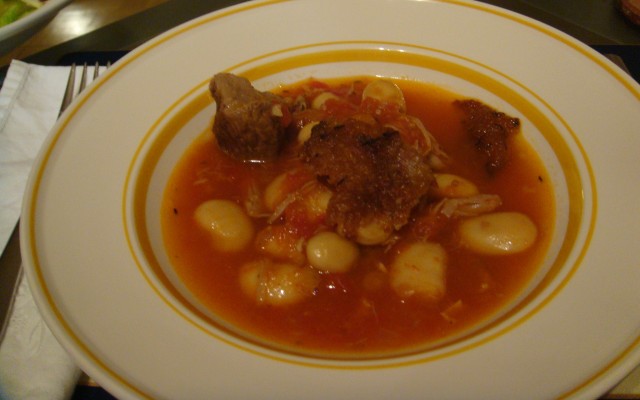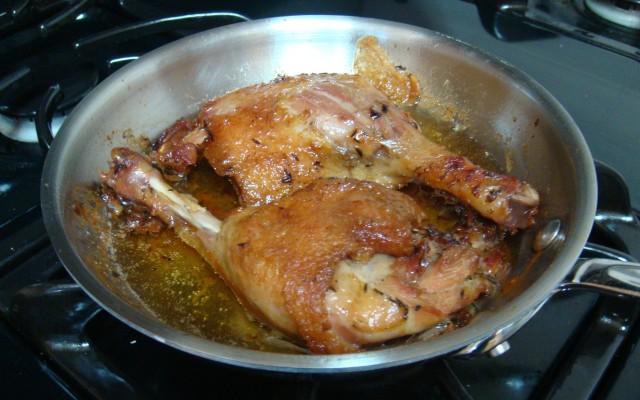 Cassoulet can be made in any of an infinite number of ways. If you get excited about this sort of thing (I do.), then it makes you wonder what the thing is, other than a word. A friend had been prattling on about his love for the dish for weeks. When finally asked what goes in it, however, he didn’t quite know, which—if you’re already excited about this sort of thing—was intriguing. And besides, a snowstorm was coming. What else was there to do.
Cassoulet can be made in any of an infinite number of ways. If you get excited about this sort of thing (I do.), then it makes you wonder what the thing is, other than a word. A friend had been prattling on about his love for the dish for weeks. When finally asked what goes in it, however, he didn’t quite know, which—if you’re already excited about this sort of thing—was intriguing. And besides, a snowstorm was coming. What else was there to do.
First, the books: The origin of the word itself is fairly straightforward, being a derivation of cassole, the vessel in which the thing—whatever it may be—is traditionally cooked. A cassole is a glazed clay pot that is narrower at the bottom than it is at the top. It looks like this.
Then, a map: The pot and the part that you eat both originate in Languedoc, a region in the south of France that is shaped like an offset U, the top pointing northwest, dipping southeast, and sitting in the middle of the bottom shelf of France, though it is generally considered southwest. I couldn’t tell you why. Being a relatively large area, with divergent resources and traditions, it’s not surprising that cassoulet would have many variations. The method remains the same, of course: cook it in that pot. What goes in it is a stickier issue.
 Finally, the French chef: Julia Child reckons that the most important element in cassoulet is flavor. Though charming and uncomplicated, this is not helpful. Larousse Gastronomique, by contrast, declares that some other gastronomical society declares that cassoulet must be composed of 70 percent beans, stock, fresh pork rind, herbs and flavorings, and 30 percent pork (which can include sausage), mutton, or preserved goose. Other acceptable meats include duck, various game, lamb, and partridge, if it’s shooting season and you shoot (I don’t). This is wretched and complicated, but helpful. People from Castelnaudary, Carcassone, Toulouse, and others will disagree vehemently over a range of details, I read, like how many times you should shove your spoon through the crust while it’s cooking. Seven or eight? This is fiddly, and you can decide whether it’s helpful. I don’t care either way.
Finally, the French chef: Julia Child reckons that the most important element in cassoulet is flavor. Though charming and uncomplicated, this is not helpful. Larousse Gastronomique, by contrast, declares that some other gastronomical society declares that cassoulet must be composed of 70 percent beans, stock, fresh pork rind, herbs and flavorings, and 30 percent pork (which can include sausage), mutton, or preserved goose. Other acceptable meats include duck, various game, lamb, and partridge, if it’s shooting season and you shoot (I don’t). This is wretched and complicated, but helpful. People from Castelnaudary, Carcassone, Toulouse, and others will disagree vehemently over a range of details, I read, like how many times you should shove your spoon through the crust while it’s cooking. Seven or eight? This is fiddly, and you can decide whether it’s helpful. I don’t care either way.
But I do like the natural conclusions, which are that Mrs. Child is right, any book that decrees the dish is this or that is cooked, and cassoulet is whatever you would like it to be.
Cassoulet à la me, or, What to Do with Cabin Fever
¼ pound pancetta, diced | 1 pound lamb shoulder, cut into 1 inch chunks | kosher salt and freshly ground pepper | olive oil, or whatever oil you prefer to cook with | 1 onion, diced | 1 big carrot, diced | 6 cloves garlic | 1 28 oz can tomatoes, preferably San Marzano | 1 bouquet garni: bay leaf, few sprigs thyme, and a couple of parsley stems, tied together with kitchen string or not | some water | 2 cups dried cannellini beans, soaked overnight | 1 confit duck leg, store bought or not | 2-3 big handfuls breadcrumbs
The day before you want to eat the cassoulet, pick a pan large and deep enough to accommodate all of the ingredients, and heat it over medium for a minute. If it can go in the oven, heat that to 325. Add a small bit of olive oil to the pan, and cook the pancetta in it until lightly browned, about 5 minutes. Remove to paper towels. Turn the heat to medium high.
Season the lamb generously with salt and pepper. Then sear it on all sides in the pork fat. Don’t rush; this could take as long as 20 minutes. Don’t crowd the pan, either. You may have to brown in batches. Remove lamb to a plate, and discard the grease in the bottom of the pan, or not. (I do.) Turn the heat to medium low, and add another bit of olive oil.
Toss in your onion and carrot. Season with salt and pepper, and let them sweat for about 3 minutes. Toss in the garlic. Let cook for another 2 minutes. Add tomatoes, bouquet garni, and perhaps that can’s worth of water. Season with salt and pepper again. Dump in the pancetta from the paper towels and the lamb from the plate, along with whatever juices accumulated on it. Bring this to a boil, cover with a lid or foil, and either place in the oven or turn the stove down to as low a heat as possible. It should simmer ever so gently. Read a book for 1½ hours.
Drain and rinse the beans. Add them to your pot. If the beans are not swimming around comfortably in the liquid, add enough water so that they are. Bring everything to a boil again, cover again, and place back in the oven, if using. Read a book for another hour. This step will be finished when the beans are just under-cooked, and the lamb has stewed for about 2½ hours. Do the math however you like. Then adjust the seasoning. Now have a drink, for the cassoulet is not done yet. Let the thing cool, cover, and refrigerate for a day or even 2.
The day you want to eat the cassoulet, heat oven to 400, and remove lamb and bean mixture from the refrigerator. Using your hands, lift the solidified fat off the top and discard. Bring it all back to a gentle simmer. Meanwhile, remove the skin from the duck leg in largest pieces and set aside. Shred the meat, and toss it in with the lamb and beans. Shredding the meat may have been heretical, but it was good.
Toss breadcrumbs with olive oil to moisten and perhaps some fresh parsley. Pour the bean, lamb, and duck mixture into a dish approximating a cassole (big top, small bottom), making sure everything is covered by the broth. Cover all of this with breadcrumbs. Bake in oven until crispy, about 20 minutes. If you like, shove your spoon through the crust in a few spots, put back in oven, allow the crust to re-form, and repeat a few times. This will set your eating time back about 40 more minutes. Either way, put the duck skin in the oven to crisp up for the last 5 minutes of cooking. Broken into large pieces, it will make a lovely garnish if you don’t eat it all before people arrive. Haven’t you waited long enough?
Serves you and 7 or more of your favorite neighbors.
{ 2 comments… read them below or add one }
I love your website. The cassoulet looks wonderful. We need to cook together when youare home
:) Why thank you! We must cook together when I’m home!!